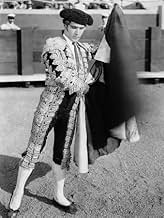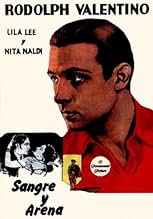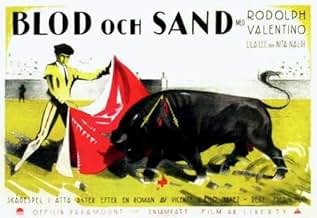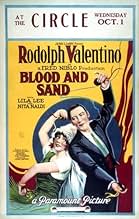CALIFICACIÓN DE IMDb
6.3/10
1.6 k
TU CALIFICACIÓN
Agrega una trama en tu idiomaA toreador's (Rudolph Valentino) familial and social life is threatened when he has an affair.A toreador's (Rudolph Valentino) familial and social life is threatened when he has an affair.A toreador's (Rudolph Valentino) familial and social life is threatened when he has an affair.
- Premios
- 1 premio ganado en total
Rudolph Valentino
- Juan Gallardo
- (as Rodolph Valentino)
Rosa Rosanova
- Angustias
- (as Rose Rosanova)
W.E. Lawrence
- Fuentes
- (as William Lawrence)
Michael Dark
- Doña Sol's New Lover
- (sin créditos)
- Dirección
- Guionistas
- Todo el elenco y el equipo
- Producción, taquilla y más en IMDbPro
Argumento
¿Sabías que…?
- TriviaThe film's editor was Dorothy Arzner, who would later go on to become Hollywood's first female director. Arzner impressed the producers by cannily interspersing stock bull-fighting footage with shots of Rudolph Valentino to make it look like the actor was actually in the ring with real bulls. This was quite a progressive technique in its day.
- ErroresThe mountain bandit who is one of the principal supporting characters is an anachronism; the Guardia Civil did away with their kind during the late 19th century.
- Citas
Juan Gallardo: We spread our capes for your amusement and most generous alms.
- ConexionesEdited into Michael Blanco (2004)
Opinión destacada
BLOOD AND SAND (Paramount, 1922), directed by Fred Niblo, stars silent screen legend Rudolph (billed Rodolph) Valentino in one of his most celebrated roles as a bullfighter from the suburbs of Seville whose rise to fame eventually puts his life into a different direction. While the title might indicate violence at the beach, such as sunbathers and swimmers encountering shark attacks, (director Steven Spielberg took care of that with his 1975 hit, JAWS), the movie only lives up to its name towards the end of the story.
Set in Spain, the plot revolves around Juan Gallardo (Rudolph Valentino), also known as "Zapaterin" (The Little Shoemaker), who longs to become a famous matador in spite of the protests from his widowed mother (Rosa Rosanova) wanting her son to have a more safer profession by following his late father's trade working as a shoemaker, but that doesn't go well with him. As his dreams become reality, Juan, having made a name for himself, is reunited with Carmen Espinosa (Lila Lee), his childhood playmate now back home from convent school. The two marry, and as he rises to the top of his profession, Juan offers her wealth and happiness. Things start to change as Juan meets and succumbs to the passionate charms of Dona Sol (Nita Naldi), niece of the Marquis De Moraimas (George Pierlot).
Of the supporting players featuring George Field as El Nacional; Rosita Marsiti as Encarnacion; Leo White as Antonio; Fred Becker as Don Jose; among others, the character who is most essential to the story is Don Joselito (Charles Belcher), a philosopher, whose home is surrounded with ancient instruments of torture (superimposed with people strapped and tied to these devises). He writes recorded documents about various people who interest him, and what is to become of them, namely Juan and his bandit friend, Plumitas (Walter Long), whose backgrounds differ but with parallel professions (Juan kills bulls while Plumitas kills men), each are to have similar ends. Joselito writes this about Juan, "Juan Gallardo has reached his goal. Will success spoil him or will his love for little Carmen overcome the plaudits of the populace and the cruelty of the national sport?"
The now familiar Vicente Blasco Ibanez story was remade successfully and memorably by 20th Century-Fox in 1941 starring Tyrone Power, Linda Darnell and Rita Hayworth in the Valentino, Lee and Naldi roles. Longer than its predecessor, the remake includes a lengthy opening tracing the early life of Juan as a boy while the Valentino original centers upon his Juan as an adult, with very little about his upbringing, thus, being mostly a dramatic story on the personal life of an acclaimed matador. In spite of its premise, BLOOD AND SAND consists of limited bullfighting scenes, compared to several used in the remake, each featuring memorable love scenes between Juan and his mistress, Dona Sol. While Nita Naldi's performance might come off as campy, Rita Hayworth's interpretation is most alluring. Fred Niblo's direction may be slow going at times, but manages to bring the culture and Spain to life, especially with their afternoon recreation as they are seem being entertained by watching a good bullfight. Ole! Ole!
Because of his early death in 1926 at age 31, the Valentino name has become immortal. BLOOD AND SAND, along with THE FOUR HOURSEMEN OF THE APOCALYSE (1921), THE SHEIK (1921) and its sequel, THE SON OF THE SHEIK (1926) have become notable titles that best personify the Valentino legend, yet, television revivals have become rare. BLOOD AND SAND did become one of the thirteen movies presented on public television's weekly series of "The Silent Years" (1971), hosted by Orson Welles, with film print from the Paul Killiam collection,accompanied by a piano score by William Perry, the print used for the Blackhawk (later Republic Home Video) distribution during the early 1990s. At one point, BLOOD AND SAND was shown on cable television on the Nostalgia Channel around 1993-4 as part of its Saturday evening showing of "When Silents Was Golden." A decade later, KINO VIDEO restored BLOOD AND SAND with clearer picture quality and corrected silent film speed, as well as some restored footage missing from the standard 82 minutes (including the opening of the Paramount logo), thus, moving its length up to 110 minutes. The KINO print is accompanied by a new score by Rodney Sauer and the Mont Alto Motion Picture Orchestra. But beware of shorter prints running at 62 minutes, the abridged print that played on numerous occasions on Turner Classic Movies' "Silent Sunday Nights" prior to 2000.
BLOOD AND SAND is classic Valentino at best. Aside from playing a young man with ambition, a tango dancer, and a lover of women (although a title card earlier in the story has him saying "I hate all women except one"), Valentino is perfectly cast as the bullfighter of Seville, and that's no bull. Viva, Valentino!
Set in Spain, the plot revolves around Juan Gallardo (Rudolph Valentino), also known as "Zapaterin" (The Little Shoemaker), who longs to become a famous matador in spite of the protests from his widowed mother (Rosa Rosanova) wanting her son to have a more safer profession by following his late father's trade working as a shoemaker, but that doesn't go well with him. As his dreams become reality, Juan, having made a name for himself, is reunited with Carmen Espinosa (Lila Lee), his childhood playmate now back home from convent school. The two marry, and as he rises to the top of his profession, Juan offers her wealth and happiness. Things start to change as Juan meets and succumbs to the passionate charms of Dona Sol (Nita Naldi), niece of the Marquis De Moraimas (George Pierlot).
Of the supporting players featuring George Field as El Nacional; Rosita Marsiti as Encarnacion; Leo White as Antonio; Fred Becker as Don Jose; among others, the character who is most essential to the story is Don Joselito (Charles Belcher), a philosopher, whose home is surrounded with ancient instruments of torture (superimposed with people strapped and tied to these devises). He writes recorded documents about various people who interest him, and what is to become of them, namely Juan and his bandit friend, Plumitas (Walter Long), whose backgrounds differ but with parallel professions (Juan kills bulls while Plumitas kills men), each are to have similar ends. Joselito writes this about Juan, "Juan Gallardo has reached his goal. Will success spoil him or will his love for little Carmen overcome the plaudits of the populace and the cruelty of the national sport?"
The now familiar Vicente Blasco Ibanez story was remade successfully and memorably by 20th Century-Fox in 1941 starring Tyrone Power, Linda Darnell and Rita Hayworth in the Valentino, Lee and Naldi roles. Longer than its predecessor, the remake includes a lengthy opening tracing the early life of Juan as a boy while the Valentino original centers upon his Juan as an adult, with very little about his upbringing, thus, being mostly a dramatic story on the personal life of an acclaimed matador. In spite of its premise, BLOOD AND SAND consists of limited bullfighting scenes, compared to several used in the remake, each featuring memorable love scenes between Juan and his mistress, Dona Sol. While Nita Naldi's performance might come off as campy, Rita Hayworth's interpretation is most alluring. Fred Niblo's direction may be slow going at times, but manages to bring the culture and Spain to life, especially with their afternoon recreation as they are seem being entertained by watching a good bullfight. Ole! Ole!
Because of his early death in 1926 at age 31, the Valentino name has become immortal. BLOOD AND SAND, along with THE FOUR HOURSEMEN OF THE APOCALYSE (1921), THE SHEIK (1921) and its sequel, THE SON OF THE SHEIK (1926) have become notable titles that best personify the Valentino legend, yet, television revivals have become rare. BLOOD AND SAND did become one of the thirteen movies presented on public television's weekly series of "The Silent Years" (1971), hosted by Orson Welles, with film print from the Paul Killiam collection,accompanied by a piano score by William Perry, the print used for the Blackhawk (later Republic Home Video) distribution during the early 1990s. At one point, BLOOD AND SAND was shown on cable television on the Nostalgia Channel around 1993-4 as part of its Saturday evening showing of "When Silents Was Golden." A decade later, KINO VIDEO restored BLOOD AND SAND with clearer picture quality and corrected silent film speed, as well as some restored footage missing from the standard 82 minutes (including the opening of the Paramount logo), thus, moving its length up to 110 minutes. The KINO print is accompanied by a new score by Rodney Sauer and the Mont Alto Motion Picture Orchestra. But beware of shorter prints running at 62 minutes, the abridged print that played on numerous occasions on Turner Classic Movies' "Silent Sunday Nights" prior to 2000.
BLOOD AND SAND is classic Valentino at best. Aside from playing a young man with ambition, a tango dancer, and a lover of women (although a title card earlier in the story has him saying "I hate all women except one"), Valentino is perfectly cast as the bullfighter of Seville, and that's no bull. Viva, Valentino!
- lugonian
- 15 may 2005
- Enlace permanente
Selecciones populares
Inicia sesión para calificar y agrega a la lista de videos para obtener recomendaciones personalizadas
- How long is Blood and Sand?Con tecnología de Alexa
Detalles
Taquilla
- Total en EE. UU. y Canadá
- USD 2,725,000
- Tiempo de ejecución1 hora 48 minutos
- Mezcla de sonido
- Relación de aspecto
- 1.33 : 1
Contribuir a esta página
Sugiere una edición o agrega el contenido que falta

Principales brechas de datos
By what name was Blood and Sand (1922) officially released in Canada in English?
Responda





































